Implementation and Performance Evaluation of Integrated Wireless MultiSensor Module for Aseptic Incubator of Cordyceps militaris
Abstract
:1. Introduction
2. Novel Wireless Multisensor Module Design
2.1. Hardware Design for Novel Wireless Multisensor Module
2.2. Software Design for Wireless Multisensor System
3. Results and Discussion
3.1. Pre-Calibration of Multisensor Module
3.2. On-Site Monitoring Results
3.3. Post-Calibration Results
3.4. Discussion
4. Conclusions
Author Contributions
Funding
Conflicts of Interest
References
- Das, S.K.; Masuda, M.; Sakurai, A.; Sakakibara, M. Medicinal uses of the mushroom Cordyceps militaris: Current state and prospects. Fitoterapia 2010, 81, 961–968. [Google Scholar] [CrossRef] [PubMed]
- Das, S.K.; Masuda, M.; Sakurai, A.; Sakakibara, M. Effects of additives on cordycepin production using a Cordyceps militaris mutant induced by ion beam irradiation. Afr. J. Biotechnol. 2009, 8, 3041–3047. [Google Scholar]
- Kang, C.; Wen, T.C.; Kang, J.C.; Meng, Z.B.; Li, G.R.; Hyde, K.D. Optimization of large-scale culture conditions for the production of Cordycepin with Cordyceps militaris by liquid static culture. Sci. World J. 2014, 2014, 510627. [Google Scholar] [CrossRef] [Green Version]
- Xie, C.Y.; Gu, Z.X.; Fan, G.J. Production of cordycepin and mycelia by submerged fermentation of Cordyceps militaris in mixture natural culture. Appl. Biochem. Biotechnol. 2009, 158, 483–492. [Google Scholar] [CrossRef]
- Wen, T.C.; Li, G.R.; Kang, J.C.; Kang, C.; Hyde, K.D. Optimization of solid-state fermentation for fruiting body growth and Cordycepin production by Cordyceps militaris. Chiang Mai J. Sci. 2014, 41, 858–872. [Google Scholar]
- Gregori, A. Cordycepin production by Cordyceps militaris cultivation on spent brewery grains. Acta Biol. Slov. 2014, 57, 45–52. [Google Scholar]
- Adnan, M.; Ashraf, S.A.; Khan, S.; Alshammari, E.; Awadelkareem, A.M. Effect of pH, temperature and incubation time on cordycepin production from Cordyceps militaris using solid-state fermentation on various substrates. Cyta J. Food. 2017, 15, 617–621. [Google Scholar] [CrossRef] [Green Version]
- Chang, D.H.; Zhao, J. Breeding Method and Production Process for Cordyceps Militaris Strain with High Cordycepin Content. 2015. Available online: htts://patentimages.storage.googleapis.com/8e/54/d6/c966acd8eefd41/CN104663252A (accessed on 3 May 2019).
- Lee, H.; Liu, N.; Song, Y.; Tian, M.J.; Xioa, Q.M.; Chang, M.; Chang, J.J.; Xioa, J.; Sun, L.P. Cordyceps Militaris Culture Medium Capable of Improving Cordycepin Content, and Preparation Method of Cordyceps Militaris Culture Medium. 2016. Available online: https://patentimages.storage.googleapis.com/d6/5e/d9/9c47f337f5d26d/CN105505784A (accessed on 3 May 2019).
- Shen, Z.J.; Lee, Y. Multi-Spore Cross Breeding Method for Cordyceps Militaris and Application. 2017. Available online: https://patentimages.storage.googleapis.com/2f/f0/5d/c71e7719ac1b29/CN107173051A (accessed on 3 May 2019).
- Firstek Scientific. Gc-101/101h Growth Chambers. 2003. Available online: https://www.chuanhua.com.tw/ch-web/pdf/p189 (accessed on 3 May 2019).
- Tsai, H.L.; Lin, J.Y.; Hsu, T.H. Taiwan Innovation Patent. NO.: I658783, 2019. Available online: https://twpat2.tipo.gov.tw/tipotwoc/tipotwekm?@@1495302830 (accessed on 11 May 2019).
- ROHM Semiconductor. Digital 16bit Serial Output Type Ambient Light Sensor Ic BH1750FVI. 2011. Available online: https://www.mouser.com/ds/2/348/bh1750fvi-e-186247 (accessed on 30 May 2019).
- AMS. ENS210-Relative Humidity and Temperature Sensor with I2C Interface. 2016. Available online: https://www.mouser.com/ds/2/588/ams_11032016_ENS210-1214724 (accessed on 30 May 2019).
- Sensirion. Datasheet Sensirion SCD30 Sensor Module. 2019. Available online: https://www.sensirion.com/fileadmin/user_upload/customers/sensirion/Dokumente/0_Datasheets/CO2/Sensirion_CO2_Sensors_SCD30_Datasheet (accessed on 30 May 2019).
- Lutron Electronics. Light Meter-Model: LX-1102. 2015. Available online: http://www.sunwe.com.tw/lutron/LX-1102 (accessed on 10 June 2019).
- Elektronics. Omniport 30. 2015. Available online: http://downloads.epluse.com/fileadmin/data/product/omniport30/datasheet_Omniport30 (accessed on 10 June 2019).

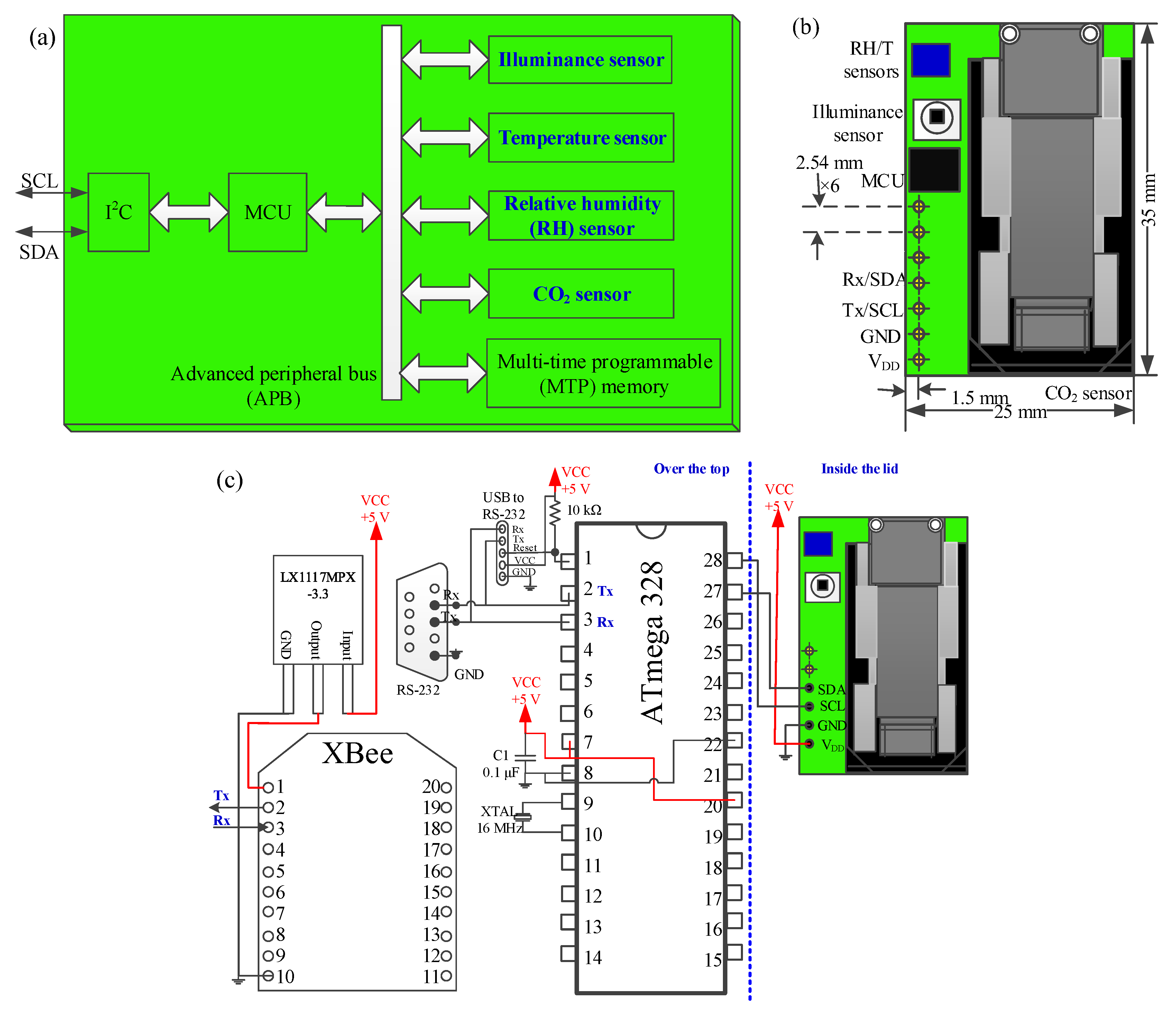
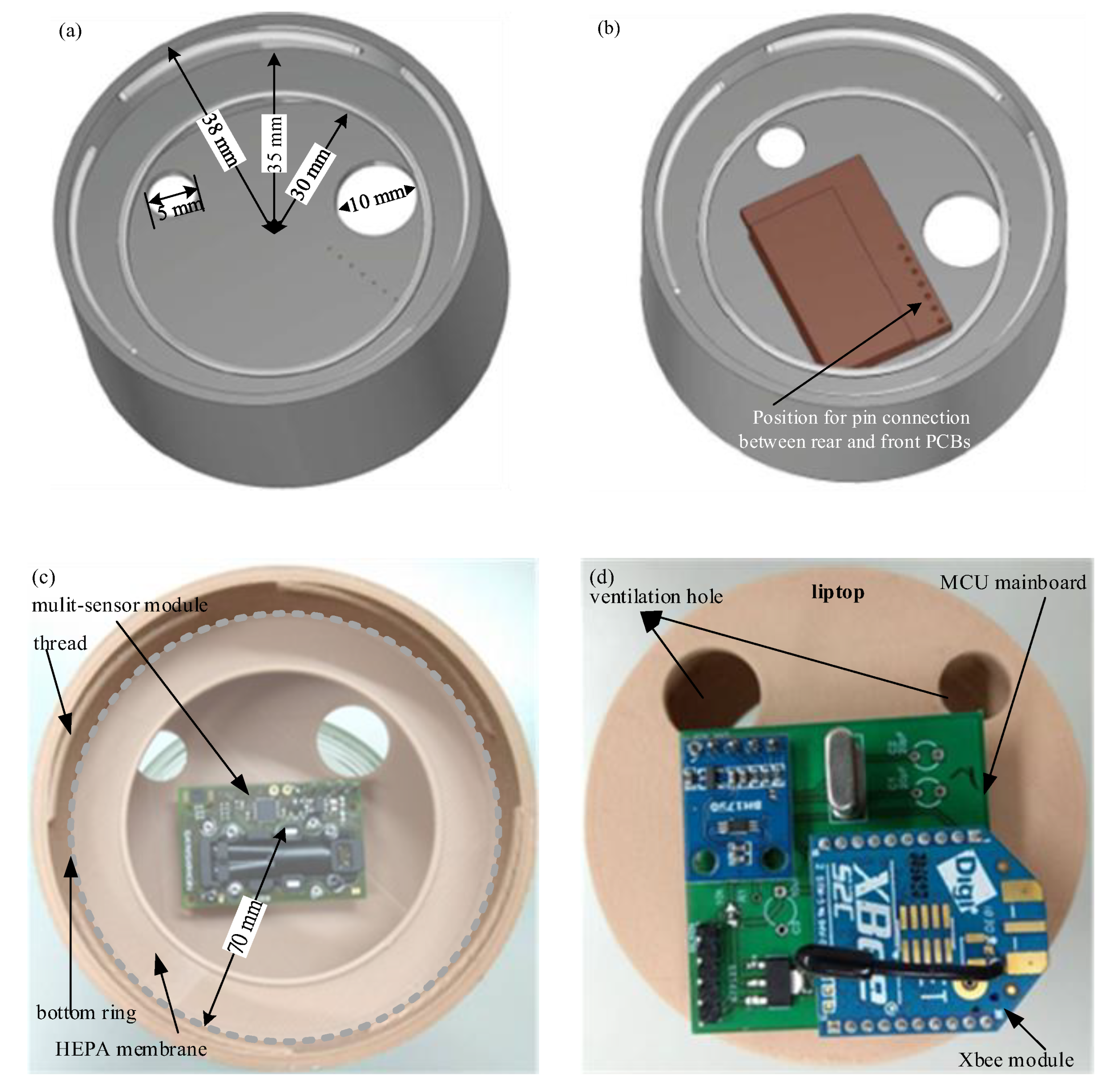

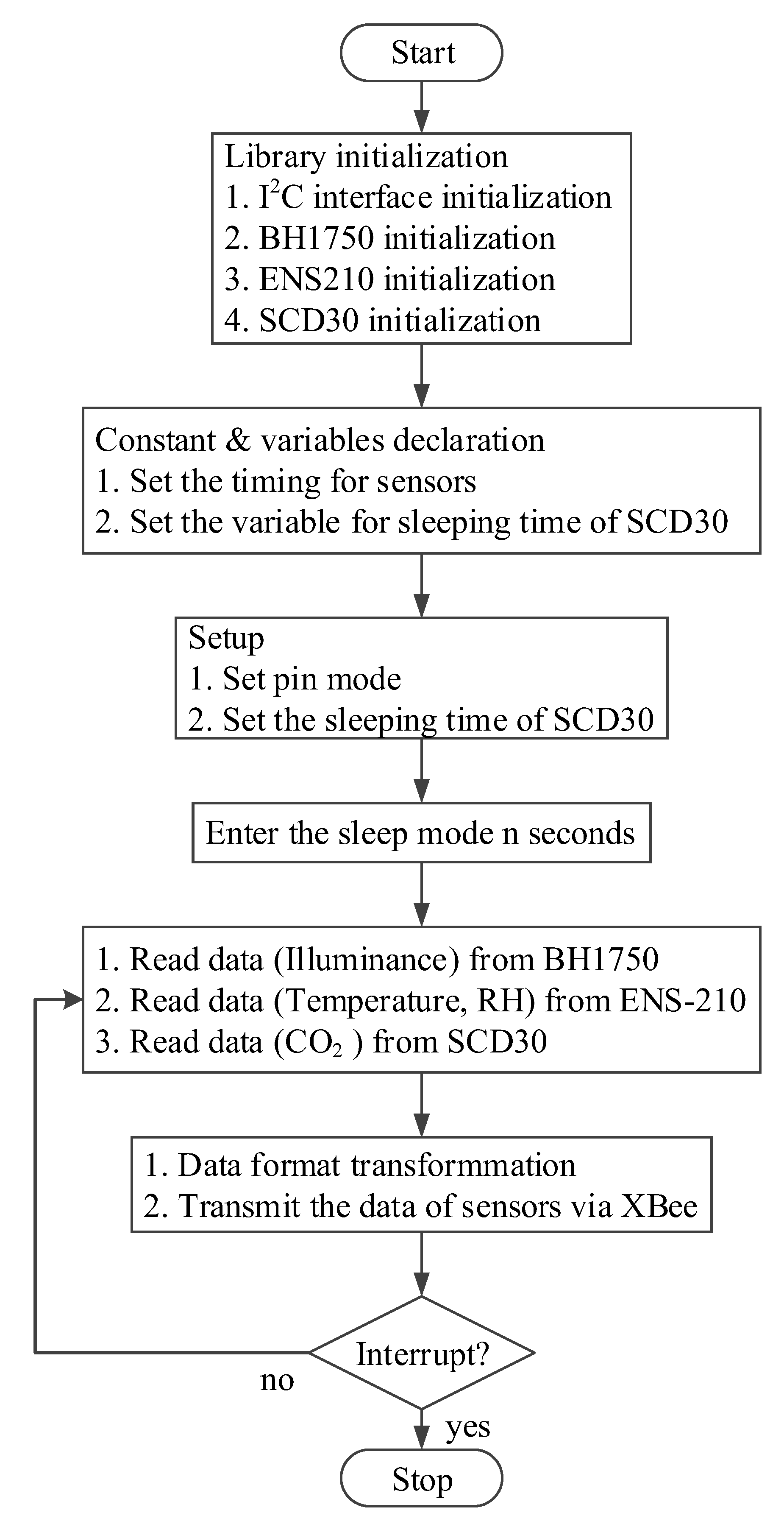

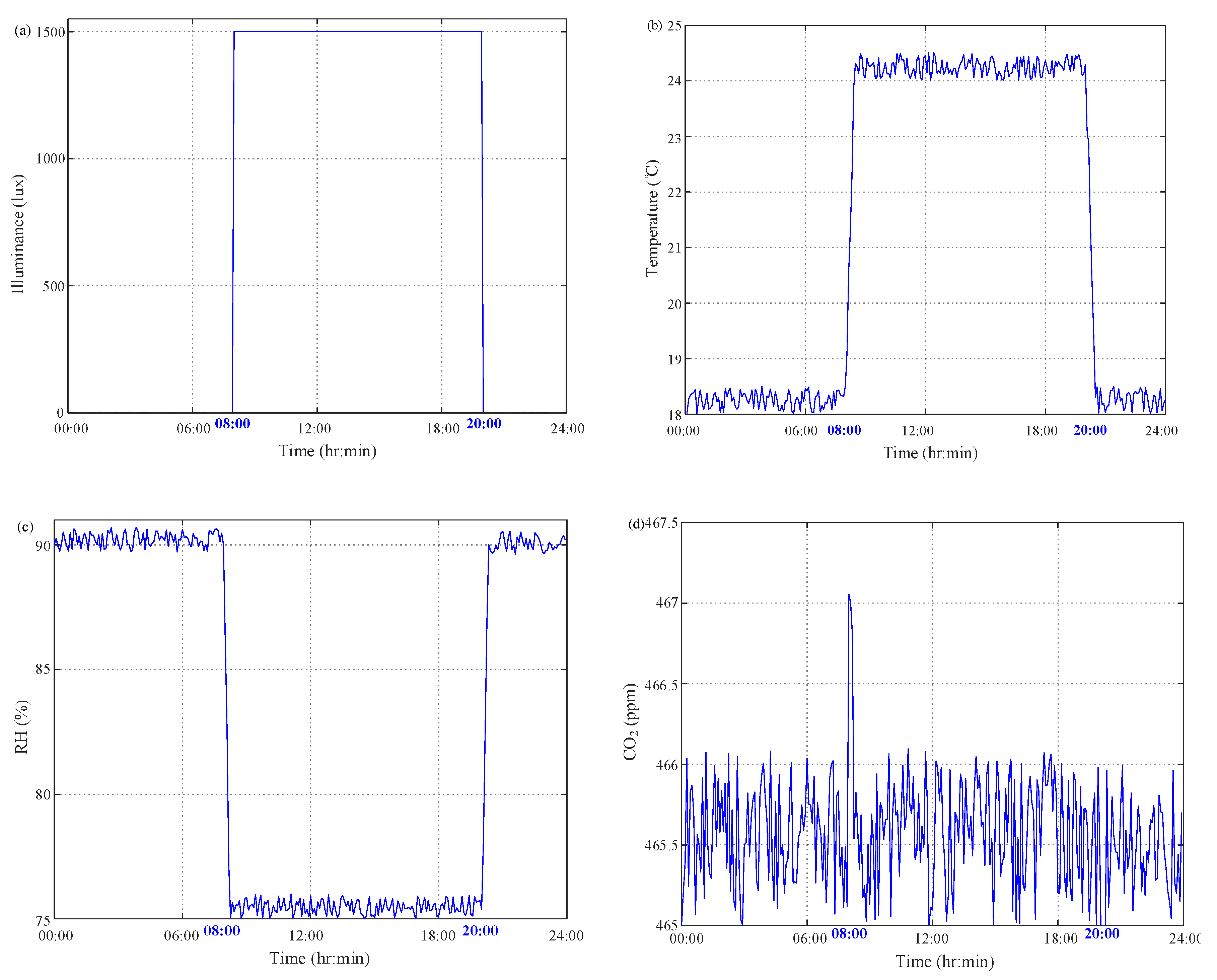
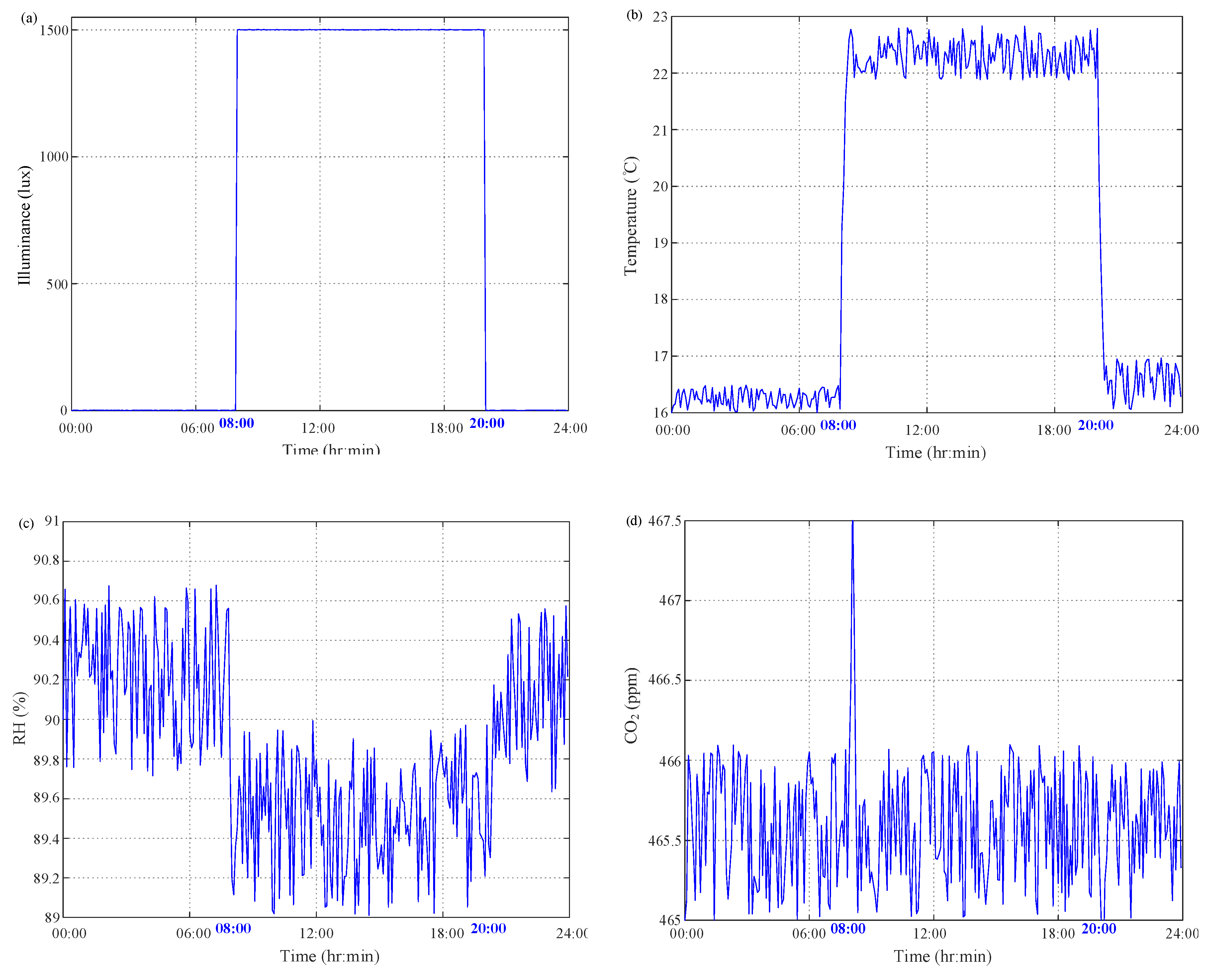

| Culture Stage | Duration | Day/Night Duty Cycle | Illuminance (lux) | Temperature (°C) | RH (%) | CO2 (ppm) |
|---|---|---|---|---|---|---|
| Dark culutre of mycelium | 1st day–day 7 | 0/24 | 0 | 20 | 60 | airtight |
| Light culutre of mycelium | day 8–day 10 | 8/16 | 1000/500 | 24/18 | 70/90 | 460 |
| Primordia culture | day 11–day 20 | 12/12 | 1000/500 | 24/18 | 75/90 | 460 |
| Fruiting-body culture | day 21–day 50 | 12/12 | 1000/500 | 22/16 | 90/90 | 460 |
| Fruiting-body harvest | day 51–day 60 | 12/12 | 1000/500 | 22/16 | 90/90 | 460 |
| Items | Pre-Calibration | Post-Calibration | |
|---|---|---|---|
| Relative erros | e(∆λ) (lux) | −1.8998~1.4457 | −1.8513~1.4224 |
| e(∆T) (°C) | −0.9449~0..8069 | −1.8513~1.4224 | |
| e(∆ψ) (%) | −1.0404~0.9166 | −1.3867~0.8874 | |
| e(∆ηCO2) (ppm) | −1.4414~1.0969 | −1.3697~1.0886 | |
| Root mean square error (RMSE) | RMSE(∆λ) (lux) | 0.7802 | 0.7984 |
| RMSE (∆T) (°C) | 0.3970 | 0.4047 | |
| RMSE (∆ψ) (%) | 0.4673 | 0.4468 | |
| RMSE (∆ηCO2) (ppm) | 0.5838 | 0.5035 | |
© 2020 by the authors. Licensee MDPI, Basel, Switzerland. This article is an open access article distributed under the terms and conditions of the Creative Commons Attribution (CC BY) license (http://creativecommons.org/licenses/by/4.0/).
Share and Cite
Lin, J.-Y.; Tsai, H.-L.; Sang, W.-C. Implementation and Performance Evaluation of Integrated Wireless MultiSensor Module for Aseptic Incubator of Cordyceps militaris. Sensors 2020, 20, 4272. https://doi.org/10.3390/s20154272
Lin J-Y, Tsai H-L, Sang W-C. Implementation and Performance Evaluation of Integrated Wireless MultiSensor Module for Aseptic Incubator of Cordyceps militaris. Sensors. 2020; 20(15):4272. https://doi.org/10.3390/s20154272
Chicago/Turabian StyleLin, Jen-Yung, Huan-Liang Tsai, and Wen-Chi Sang. 2020. "Implementation and Performance Evaluation of Integrated Wireless MultiSensor Module for Aseptic Incubator of Cordyceps militaris" Sensors 20, no. 15: 4272. https://doi.org/10.3390/s20154272






